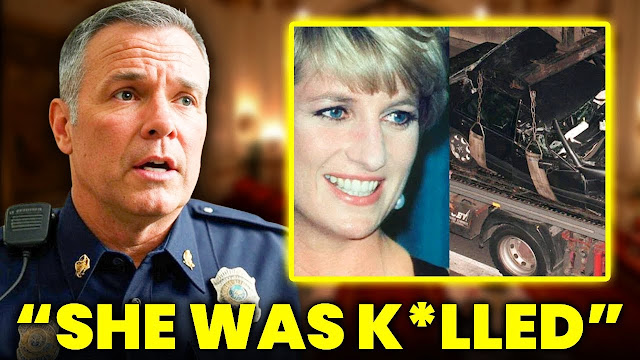Ads
It was clear to many that Princess Diana’s life was in danger, though no one could predict exactly when or how. Her tragic death in the Alma Tunnel in Paris shocked the world and left behind an avalanche of unanswered questions. While the official narrative pointed to a high-speed crash caused by an intoxicated driver, layers of secrecy and conflicting details continued to fuel suspicion. Recently, a senior police figure has come forward with statements that may finally shed new light on that devastating night—reigniting debates about what really happened to the People’s Princess.
August 31st, 1997, started like any other evening for Diana and her companion, Dodi Al-Fayed. They left the Ritz Hotel in Paris and got into a Mercedes, unaware they were taking their final ride. Henry Paul, the hotel’s deputy head of security, was behind the wheel. Driving at dangerous speeds through the Pont de l’Alma tunnel, the car lost control and struck a pillar. Diana, Dodi, and Paul perished in the wreckage. Only Diana’s bodyguard, Trevor Rees-Jones, survived, though seriously injured and forever changed by the trauma.
Ads
French authorities immediately began an investigation. By 1999, they concluded that Henry Paul was under the influence of alcohol and prescription medication, making him unfit to drive. Although this explanation offered some closure, it didn’t stop speculation. Many believed there was more to the story—perhaps something much darker.
In 2004, a British inquiry—Operation Paget—was launched, partly to revisit evidence and partly to address the growing number of conspiracy theories. One major twist came in 2003 when a hidden letter written by Diana was made public. In it, she expressed her fear of being killed in a staged car accident. She mentioned the possibility of brake failure and a head injury, suggesting she believed her life might be intentionally ended so Prince Charles could remarry. The note, entrusted to her former butler Paul Burrell, deeply disturbed those who read it. Though Burrell later said he didn’t believe Prince Charles plotted anything, he acknowledged that Diana felt genuinely threatened.
Ads
The letter raised red flags for investigators. Officer David Douglas from Operation Paget remarked that the letter gave a heartbreaking glimpse into Diana’s mental state in 1995. While the investigation still leaned toward a tragic accident, her words revealed a woman gripped by fear and suspicion—feelings that couldn’t be dismissed.
The sense of mystery deepened with accounts from royal journalists and Dodi’s father, Mohamed Al-Fayed. They insisted that Diana’s death was orchestrated, not accidental. Mohamed had long claimed there was a conspiracy, and the letter appeared to support his theory. A public inquest in Britain, delayed for years, finally began in 2007 under Lord Justice Scott Baker. It followed a series of setbacks: the first coroner died, the second resigned, and the third withdrew after public backlash over concerns she would hold the proceedings in private. The fourth coroner took charge and opened the inquiry fully to the public.
Ads
The inquest covered a broad range of issues. Jurors examined surveillance footage, statements from eyewitnesses, expert reports, and even personal letters from Prince William, Prince Harry, and Prince Philip. Diana’s final night was reconstructed piece by piece, including footage showing her and Dodi holding hands just before entering the car—offering an emotional image of human connection before disaster struck.
There were also contradictions in the investigation’s findings. Henry Paul’s toxicology results showed high alcohol levels, yet surveillance tapes from that evening captured him walking straight, bending over, and moving without any signs of intoxication. This raised doubts about the reliability of the blood tests and the possibility that they were tampered with to shift blame.
The inquest also considered whether Diana had expressed real concerns for her safety. Months before her death, she had voiced fears about being harmed. She had even spoken with her lawyer about feeling unsafe and requested more security, but her concerns weren’t taken seriously. Commander Jeffson, a police officer she confided in, later admitted he believed her to some degree.
Ads
Throughout this period, Diana remained composed. Despite being labeled unstable by the media, she continued with her duties and made light of rumors in public appearances. Those closest to her saw a resilient woman coping with immense pressure—from her failed marriage, the royal family’s coldness, and the glare of global attention.
In the summer of 1997, Diana began a relationship with Dodi Al-Fayed. Their time together included a luxurious Mediterranean trip aboard the Jonikal yacht and some moments of genuine happiness. But the attention was relentless. Paparazzi hounded them in Paris. On the night of the crash, their every move was tracked.
As the couple tried to escape the media, a secret exit plan was devised. Decoy vehicles were arranged. The idea was to slip Diana and Dodi out the back of the hotel while distracting the press out front. Henry Paul was chosen to drive. He appeared calm on security footage, even stopping to tie his shoelaces—just moments before he would take the wheel for the last time.
But the timeline had gaps. Paul disappeared for nearly three hours before returning to the Ritz, and no one could account for where he had been. This void in the timeline only fueled further questions. Where had he gone? Who had he met? Was he manipulated?
As the night unfolded, Paul made several odd visits outside the hotel, interacting with paparazzi and drivers. His movements, caught on tape, suggested preparation—but for what? After the crash, the media descended on the scene, flashing cameras turning tragedy into spectacle. Diana’s death became more than a royal loss—it became a moment frozen in global grief.
The inquest explored all of this. It wasn’t just about how Diana died—it was about why. Was it simply a tragic accident, or was something more sinister at play? No smoking gun was ever found, but the shadows surrounding that night refuse to fade. Diana’s voice, through her now-famous letter, still echoes—full of fear, warnings, and premonitions.


Post a Comment